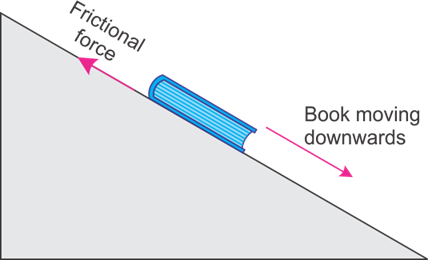NCERT Solutions for Class 8 Science Chapter 9 Friction help students to clear all their doubts. These solutions provide you with the answers to all the questions given in the NCERT textbook. CBSE Class 8 Science Chapter 9 Solutions is prepared by expert teachers as per the latest CBSE syllabus and guidelines.
Solving NCERT Solutions will help you to understand the concepts related to Friction. NCERT Solutions for Class 8 Science Chapter 9 contains an in-depth explanation of each question of NCERT Science textbook. These solutions cover important concepts in different patterns like MCQs and short answer questions, worksheets and more and help you top score good marks in the exam.
Class 8 Science Friction Questions and Answers
Exercise Questions
Question 1: Fill in the blanks.
(a) Friction opposes the _____________ between the surfaces in contact with each other.
(b) Friction depends on the _____________ of surfaces.
(c) Friction produces __________.
(d) Sprinkling of powder on the carrom board ________ friction.
(e) Sliding friction is ___________ than the static friction.
Answer:
(a) Friction opposes the motion between the surfaces in contact with each other.
(b) Friction depends on the nature of surfaces.
(c) Friction produces heat.
(d) Sprinkling of powder on the carrom board reduces friction.
(e) Sliding friction is lesser than the static friction.
Question 2: Four children were asked to arrange forces due to rolling, static and sliding frictions in a decreasing order. Their arrangements are given below. Choose the correct arrangement.
(a) rolling, static, sliding
(b) rolling, sliding, static
(c) static, sliding, rolling
(d) sliding, static, rolling
Answer: (c) static, sliding, rolling
Question 3: Alida runs her toy car on dry marble floor, wet marble floor, newspaper and towel spread on the floor. The force of friction acting on the car on different surfaces in increasing order will be
(a) wet marble floor, dry marble floor, newspaper and towel.
(b) newspaper, towel, dry marble floor, wet marble floor.
(c) towel, newspaper, dry marble floor, wet marble floor.
(d) wet marble floor, dry marble floor, towel, newspaper
Answer: (a) wet marble floor, dry marble floor, newspaper and towel.
Question 4: Suppose your writing desk is tilted a little. A book kept on it starts sliding down. Show the direction of frictional force acting on it.
Answer: Friction force acts opposite to the motion of the book.

Question 5: You spill a bucket of soapy water on a marble floor accidently. Would it make it easier or more difficult for you to walk on the floor? Why?
Answer: It would be difficult to walk on the floor. Soapy water fills the floor irregularities, thus reduces the friction considerably. Feet do not make a necessary grip with the floor surface, thus increasing the chances of falling.
Question 6: Explain why sportsmen use shoes with spikes.
Answer: Spikes increase friction and give better grip with the ground. It avoids slipping of sportsmen while playing or running.
Question 7: Iqbal has to push a lighter box and Seema has to push a similar heavier box on the same floor. Who will have to apply a larger force and why?
Answer: Friction force is directly proportional to mass. Heavier box will put more force on the floor surface as compared to the lighter box and therefore will experience more opposite force (friction). Seema will have to apply larger force.
Question 8: Explain why the sliding friction is less than the static friction.
Answer: When the objects are at rest, the interlocking of irregularities in the two surfaces of the objects is higher than that of when objects are moving. When objects are moving, there is less interaction between their surfaces. That’s why sliding friction is less than static friction.
Question 9: Give examples to show that friction is both a friend and a foe.
Answer: Friction is both a friend and a foe due to following reasons:
Friction act as friend:
- We are able to walk because of frictional forces between the ground and our feet.
- We are able to write because of friction between ballpoint and the paper surface.
- Nails and screws stick to wall surfaces because of friction.
- Lighting a match stick is because of friction between match stick and the side surface of matchbox.
Friction act as foe:
- Wear and tear of soles of our shoes are due to friction.
- When a tyre deflates, it is difficult to move the vehicle because of increased friction between the tyre and road surface.
- Machines get heated up because of friction.
- Due to friction, machines and vehicles consume more fuel and increase maintenance cost.
Question 10: Explain why objects moving in fluids must have special shapes.
Answer: The frictional force exerted by fluids is also called drag or fluid friction. To overcome or minimize air-fluid friction, the bodies of objects minimise its surface i.e. sometimes spherical shapes or other streamlined shapes with a smooth surface. Aeroplanes, jets, raindrops have streamlined curve surface to reduce air drag.